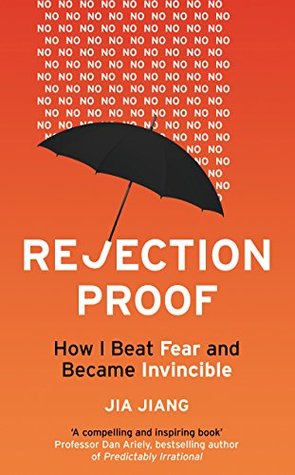More on this book
Community
Kindle Notes & Highlights
by
Jia Jiang
Read between
January 17 - October 3, 2020
But if acceptance is the only thing a person strives for, all she or he needs to do is to talk to enough people. Odds are that someone will eventually say yes.
If I could adjust my request and approach the “ask” from a different angle, something interesting and unexpected might happen—and it often did.
because most people don’t want to feel like jerks, they are much less likely to say no the second time to the requester after the requester makes a concession.
Every no is actually surrounded by a whole bunch of interesting but invisible yeses that it was up to me to uncover.
If you get turned down for a job, one option is to flee—but another option is to ask for recommendations for other positions based on your qualifications.
But after I shifted that thinking and started viewing them as collaborators, I suddenly found myself in whole new territory.
On the flip side, the opposite of collaboration—argument—is a magnet for rejection.
Arguing with a person who turns you down is probably the least effective way to change the individual’s response.
I’d approached the music studio employee as a collaborator, and that switch in approach had changed his mind. By making it clear that he had the freedom to say no, I got to the yes we were looking for.
book Think Like a Freak.
But instead of quitting, I found that stepping back and trying again under different circumstances could yield a different result. I call it “switch up.”
Another way to “switch up” is to change environments.
rejection is not always the end of the story.
Hanging on for dear life and giving up by quitting are not the only two options left after a no. Instead, sometimes you need to step back and reevaluate your talents and dreams, as well as the conditions and the environment in which you have been trying to get an acceptance.
LESSONS
1. Ask “Why” Before Good-bye:
2. Retreat, Don’t Run:
3. Collaborate, Don’t Contend:
4. Switch Up, Don’t Give Up:
CHAPTER 7 POSITIONING FOR YES
Jiro Ono,
2011 documentary Jiro Dreams of Sushi.
getting a yes involves persuasion,
GIVE MY “WHY”
“The best things in life are free, but you can keep them for the birds and bees. Now give me money, that’s what I want.” —BARRETT STRONG IN THE SONG “MONEY”
asking people why after receiving a rejection helped me understand their reasoning and sometimes turn a no into a yes—or into an even more interesting offer.
explaining my why up front had a similar effect.
In 1978, Harvard psychologist Ellen Langer conduc...
This highlight has been truncated due to consecutive passage length restrictions.
She wanted to see if the way that she worded the request had an effect on their response.
When she said, “Excuse me, I have five pages. May I use the Xerox machine?,” 60 percent of people allowed her to go ahead of them.
When she added her reason, asking, “Excuse me, I have five pages. May I use the Xerox machine because I’m in a rush?,” he...
This highlight has been truncated due to consecutive passage length restrictions.
third variation, she also gave a reason, but purposely designed it to be ridiculous: “Excuse me, I have five pages. May I use the Xerox machine because I have to make some copies?” Shockingly, the number of people who...
This highlight has been truncated due to consecutive passage length restrictions.
Langer’s experiment—dubbed “The Copy Machine”—became a landmark ...
This highlight has been truncated due to consecutive passage length restrictions.
people’s responses to a request are deeply influenced by knowing there is a reason behind it, no...
This highlight has been truncated due to consecutive passage length restrictions.
START WITH “I”
In his classic bestselling book How to Win Friends and Influence People, Dale Carnegie advocates “becoming genuinely interested in other people” and “talking in terms of the other man’s interest.”
100 DAYS OF REJECTION: GIVE A HAIRCUT TO A HAIRDRESSER
James Pennebaker, a social psychologist at the University of Texas at Austin, once conducted research on the way people use pronouns in their e-mails. He discovered that the more people use the pronoun “I,” the more likely they are telling the truth and are perceived as such. On the other hand, the more people use “you” or “he/she/they” as the subject of a sentence, the more likely they are to be not telling the truth.
ACKNOWLEDGE DOUBTS
I’d come to recognize a certain look that would pass over other people’s faces as soon as they heard one of my requests. It was a combination of surprise, confusion, and suspicion.
How do I know this guy has no unfriendly intentions? How do I know he isn’t trying to sell me a bridge, recruit me to a cult, or steal my identity?
How could I make them more comfortable when talking to me?
100 DAYS OF REJECTION: BE A STARBUCKS GREETER
her to leave. Eric didn’t want a replay of that experience, and part of his hesitation
acknowledging others’ doubts can strengthen rather than destroy your credibility.
By being “real” and acknowledging the skepticism that other people might feel, you can help put them at ease, yourself at ease, and boost your credibility at the same time.
TARGET THE AUDIENCE
100 DAYS OF REJECTION: GIVING A COLLEGE LECTURE
To this day, I still can’t believe that things that mean so much to me could happen that fast if I just asked for them.
one of the most important lessons I learned through my 100 Days of Rejection: target the right audience.


